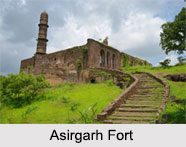 Situated about 20 km north of the city of Burhanpur, the Asirgarh Fort stands tall on the Satpura Ranges in the Indian state of Madhya Pradesh. Overlooking a pass through the Satpuras that connected the Narmada and Tapti river valleys, Asirgarh historically safeguarded a key trade route between medieval north India and the Deccan. Hence it was popularly known as the Doorway to the Deccan.
Situated about 20 km north of the city of Burhanpur, the Asirgarh Fort stands tall on the Satpura Ranges in the Indian state of Madhya Pradesh. Overlooking a pass through the Satpuras that connected the Narmada and Tapti river valleys, Asirgarh historically safeguarded a key trade route between medieval north India and the Deccan. Hence it was popularly known as the Doorway to the Deccan.
Etymology of the Asirgarh Fort
The Asirgharh Fort was built under the patronage of the Ahir dynasty king Asa Ahir. The fort was previously known as Asa Ahir Garh, which was later changed to Asirgarh.
History of the Asirgarh Fort
Ancient and old Pali Buddhist scriptures have been discovered in many regions of Rajasthan relating to the Rajputs of Mori and the Parmara dynasty. Asirgarh was a stronghold of the Hindu Rajputs but fell to the Mughal sultanate of Delhi in the late 13th century. King Asa Ahir built the fort in the early 15th century. Asa Ahir was murdered and the fort was then treacherously taken from him by Nasir Khan of the Farooqi dynasty of the Khandesh Sultanate. His successor Miran Adil Khan II was a powerful ruler of the Khandesh Sultanate, who fortified the Asirgarh Fort and built the citadel of Burhanpur. He declared his independence from Gujarat and stopped paying tributes to the Mughals. As a result, Humayun"s army descended on Asirgarh after his conquest of Gujarat in 1536 AD.
In the summer of 1577 A.D, Adil Shah, also known as Raja Ali Khan, was asked to surrender to Akbar, when the latter had sent an expedition to Khandesh. To avoid an unequal contest with Akbar, the former dropped his royal title of "Shah" and pledged suzerainty to Akbar. Later, Khandesh was used as a base for the conquest of the Deccan. Adil Shah constructed many new structures: Jama Masjid in the upper portion of the fort of Asir in 1588 AD, Idgah at Asir, Jama Masjid at Burhanpur in 1590 AD, mausoleums and Serai at Burhanpur and a mosque at Zainabad. During the Mughal era, it was considered that the Deccan started from the pass of the Satpuras, while the empire of Asirgarh to Delhi was Hindustan.
Bahadur Khan, the successor of Adil Shah declared his independence and refused to pay homage to Akbar and his son Daniyal. This angered Akbar, who marched to the city of Burhanpur and laid a historic siege for almost a year and conquered the fort of Asirgarh. Akbar"s success opened the way for later Mughal operations in the Deccan. The fortress was later held by the Hindu Marathas, whose lands lay to the west and from whom it was twice captured, in 1803 and 1819, by the British.
Architecture of the Asirgarh Fort
The Asirgarh Fort is made up of stone, lead and limestone. The architecture of the fort was influenced by the Mughals, with a mix of Islamic, Persian, Turkish and Indian touch. The tombs and balconies show the royalty of the medieval Indian architecture. There are also three man-made ponds to provide water supply. Apart from the Hindu and Muslim architecture, some ruins are of British origin.
Tourism in Asirgarh Fort
The ancient Hindu temple known as the temple of Gupteshwar Mahadev Mandir is dedicated to Lord Shiva and is a famous tourist attraction. Tales depict that Ashwatthama, a character from the Indian epic Mahabharata, used to visit this temple to worship and offer flowers to Lord Shiva.
Other attractions like the ruined mosque called the Asir Masjid, a gurudwara and the graveyards of many deceased Britishers with intact tombstones are inside the Fort.
Visiting Information for the Asirgarh Fort
Asirgarh Fort is 20 km from the city of Burhanpur, with its nearest airport being at Indore. From Indore one can take the National Highway 27 to reach the city. Burhanpur has its own railway station.



















